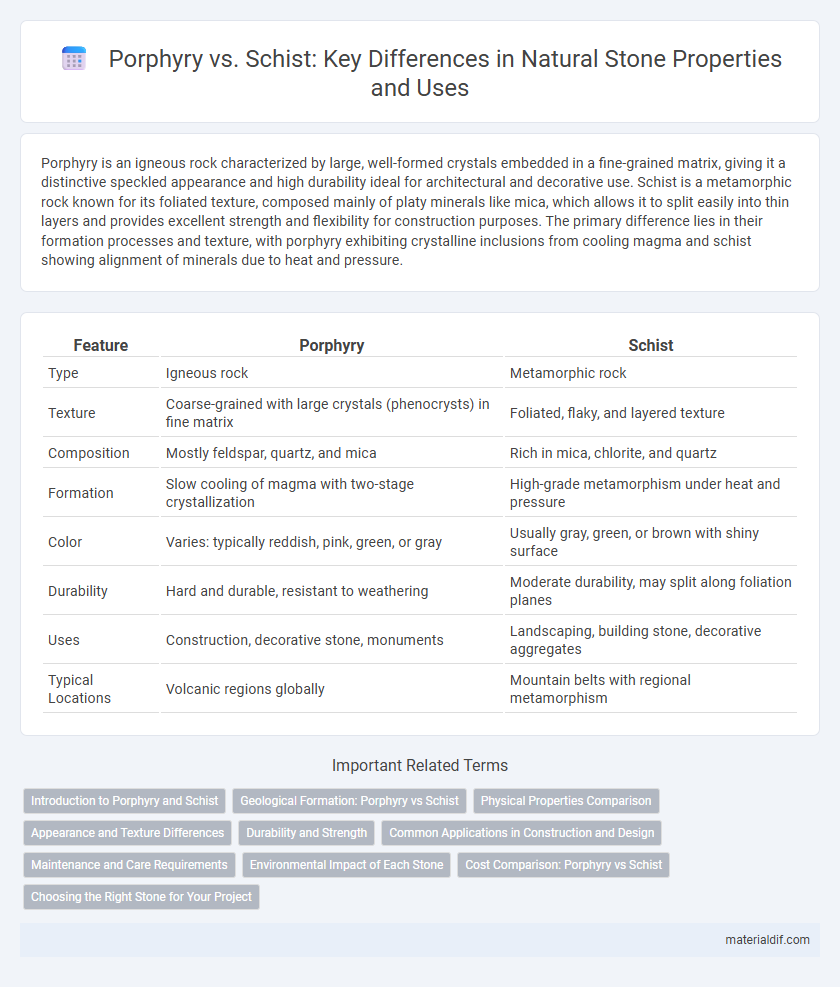Porphyry is an igneous rock characterized by large, well-formed crystals embedded in a fine-grained matrix, giving it a distinctive speckled appearance and high durability ideal for architectural and decorative use. Schist is a metamorphic rock known for its foliated texture, composed mainly of platy minerals like mica, which allows it to split easily into thin layers and provides excellent strength and flexibility for construction purposes. The primary difference lies in their formation processes and texture, with porphyry exhibiting crystalline inclusions from cooling magma and schist showing alignment of minerals due to heat and pressure.
Table of Comparison
| Feature | Porphyry | Schist |
|---|---|---|
| Type | Igneous rock | Metamorphic rock |
| Texture | Coarse-grained with large crystals (phenocrysts) in fine matrix | Foliated, flaky, and layered texture |
| Composition | Mostly feldspar, quartz, and mica | Rich in mica, chlorite, and quartz |
| Formation | Slow cooling of magma with two-stage crystallization | High-grade metamorphism under heat and pressure |
| Color | Varies: typically reddish, pink, green, or gray | Usually gray, green, or brown with shiny surface |
| Durability | Hard and durable, resistant to weathering | Moderate durability, may split along foliation planes |
| Uses | Construction, decorative stone, monuments | Landscaping, building stone, decorative aggregates |
| Typical Locations | Volcanic regions globally | Mountain belts with regional metamorphism |
Introduction to Porphyry and Schist
Porphyry is an igneous rock characterized by large, well-formed crystals, or phenocrysts, embedded in a fine-grained matrix, often composed of feldspar or quartz. Schist is a metamorphic rock distinguished by its foliated texture, with platy minerals like mica aligned in layers that facilitate cleavage. Both rocks exhibit distinct formation processes: porphyry forms from slow cooling magma, while schist results from high-temperature and pressure metamorphism of sedimentary or igneous precursors.
Geological Formation: Porphyry vs Schist
Porphyry forms through the slow cooling of magma deep within the Earth's crust, resulting in large, well-formed crystals embedded in a fine-grained matrix. Schist develops from the metamorphism of sedimentary rocks under intense heat and pressure, producing a foliated texture with visible mineral grains aligned in layers. These distinct geological formations highlight porphyry's igneous origin versus schist's metamorphic processes.
Physical Properties Comparison
Porphyry features large, conspicuous crystals embedded in a fine-grained matrix, giving it a coarse and uneven texture, while schist displays a foliated structure with aligned mineral grains, resulting in a flaky and layered appearance. Porphyry generally exhibits higher hardness and greater resistance to weathering due to its crystalline composition, whereas schist is softer and more prone to splitting along its foliation planes. The density of porphyry tends to be higher, reflecting its igneous origin, compared to the metamorphic schist, which often contains mica and other sheet silicates that reduce its overall weight.
Appearance and Texture Differences
Porphyry features large, embedded crystals called phenocrysts set in a finer-grained matrix, giving it a striking, speckled appearance with a coarse texture. Schist exhibits a foliated texture with visible, aligned mineral grains such as mica, creating a shiny, layered surface that often glistens. The contrast between porphyry's coarse, crystalline structure and schist's flaky, foliated texture is a key factor in their identification and application in construction and decorative stone.
Durability and Strength
Porphyry exhibits exceptional durability due to its crystalline texture and high quartz content, making it significantly stronger than schist. Schist, characterized by its foliated structure and weaker bonding between mineral layers, tends to be more prone to splitting and weathering over time. Porphyry's superior compressive strength and resistance to abrasion make it ideal for construction requiring long-lasting and robust stone materials.
Common Applications in Construction and Design
Porphyry, known for its durability and aesthetic appeal with large feldspar crystals, is commonly used in high-end flooring, paving, and decorative facades, providing a luxurious and long-lasting surface. Schist, characterized by its foliated texture and ease of splitting, finds frequent use in wall cladding, roofing, and landscaping due to its natural, rustic appearance and versatility. Both stones enhance architectural projects but serve different functional and stylistic roles based on their distinct physical properties and visual textures.
Maintenance and Care Requirements
Porphyry requires minimal maintenance due to its dense, hard composition, making it highly resistant to scratches, stains, and weathering, which is ideal for outdoor paving and heavy traffic areas. Schist, characterized by its foliated texture and softer mineral layers, demands more frequent sealing and careful cleaning to prevent moisture penetration and surface erosion. Regular inspection and prompt repair of schist surfaces help maintain durability, while porphyry's robust nature allows for longer intervals between maintenance tasks.
Environmental Impact of Each Stone
Porphyry, known for its durability and low porosity, has a comparatively lower environmental impact due to longer lifespan and reduced frequency of replacement in construction. Schist, being a more layered and foliated stone, often requires more processing and stabilization treatments that can increase energy consumption and environmental footprint. Extraction and quarrying activities for both stones contribute to habitat disruption, but the higher demand for schist in decorative applications typically results in more intensive resource use.
Cost Comparison: Porphyry vs Schist
Porphyry typically costs more than schist due to its rarity and unique crystalline texture, which requires specialized quarrying and processing methods. Schist, being more abundant and easier to extract, offers a more budget-friendly option for construction and decorative projects. The price difference can vary significantly based on regional availability and the quality grade of each stone.
Choosing the Right Stone for Your Project
Porphyry offers exceptional durability and a distinctive coarse-grained texture, making it ideal for high-traffic outdoor applications and decorative features requiring long-lasting appeal. Schist, characterized by its layered, foliated structure and ease of splitting, suits indoor use and accent walls where a natural, rustic aesthetic is desired. Selecting the right stone depends on balancing porphyry's strength and polishability against schist's textural charm and versatility in design.
Porphyry vs Schist Infographic

 materialdif.com
materialdif.com